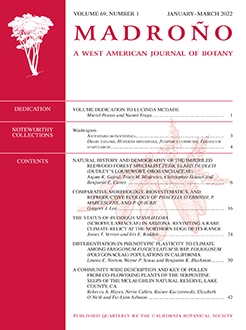The use of mechanical thinning as a restoration tool in second-growth Sequoia sempervirens (D.Don) Endl. forests is becoming increasingly common, yet little is known about how this treatment affects understory plant communities. The shade tolerant herbaceous species common to the Coast Redwood forest are known to be sensitive to disturbance and may provide a metric for assessing the recovery of the plant community as a whole. Stratified random sampling was used to compare understory composition in old-growth reference stands, naturally recovering forests (57–65 years old), and sites treated with variable density thinning (65 years old; 10–12 years post thinning) in Redwood National Park. Pairwise permutational multivariate analysis of variance (PerMANOVA) indicated greater abundance of native herbs, and lower abundance of non-natives, in old-growth and naturally recovering second-growth compared to thinned stands. Non-metric multidimensional scaling suggested that un-thinned sites were more similar to old-growth than thinned sites in regard to understory composition and abundance, and indicator species analysis returned a suite of indicator species shared between naturally recovering plots and old-growth plots (Pteridium aquilinum (L.) Kuhn; Trillium ovatum Pursh; Dryopteris arguta (Kaulf.) Maxon; Blechnum spicant (L.) Roth; Vaccinium ovatum Pursh; Gaultheria shallon Pursh; Rubus spectabilis Pursh; Rhododendron macrophyllum D.Don ex G.Don), while thinned plots shared only one indicator species with old-growth (Goodyera oblongifolia Raf.). In addition, both old-growth and naturally recovering un-thinned second-growth sites were dominated by residual species, while thinned plots were dominated by invader species.
How to translate text using browser tools
21 April 2022
UNDERSTORY RESPONSE TO RESTORATION ALTERNATIVES IN A SEQUOIA SEMPERVIRENS (CUPRESSACEAE) FOREST
Alyssa Hanover,
Will Russell
ACCESS THE FULL ARTICLE

Madroño
Vol. 69 • No. 1
January–March 2022
Vol. 69 • No. 1
January–March 2022
Coast redwood
mechanical thinning
natural recovery
old-growth
residual species




